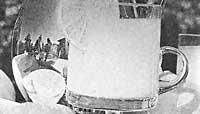Sed: an alarm signal
1987/02/01 Agirre, Jabier - Medikua eta OEEko kidea Iturria: Elhuyar aldizkaria
One of the main components of our body (not to say the main one) is water, a supplement that remains constant within certain measures or limitations. About 60% of an adult's body weight is water. This percentage varies depending on body fat: while in thin or thin people it is 65%, in thick or obese people it decreases up to 55%. If we took the body without total fat, which is almost impossible, the proportion of water would remain much more constant, 75%.
Water is distributed in two large spaces in the body: two-thirds inside the cells and the rest in extracellular fluids (blood, lymph, etc. ). ). And this distribution is closely linked to the content of mineral salts and organic substances in water; while the cellular interior is rich in potassium ions, extracellular fluids abound in sodium ions. Sodium and potassium are kept in their own spaces, but water can cross the membranes, passing the intracellular ones to the outside and vice versa.

When water loss occurs in the extracellular space, the cells offer a portion of their water as compensation. In this situation the cells suffer a certain dehydration that we could call CELLULAR THIRST. The cells of our body accept very small variations in the amount of water, and therefore, in order to maintain a normal life situation, the water that comes out to the outside needs fluid for the body and is normally ingested through drinks.
In normal conditions, in a climate like ours and with a life like ours, every day two and a half liters of water are lost: a liter and a half of urine (when it comes to pix), 30 ml of breathing, another half litromedia through the skin (although it does not sound) and the rest in the feces. In any case, joy recovers every day all that lost water, with what we drink (at least one liter), with the water of what we eat (about another liter) and the water that is generated from the reactions of our metabolism (about 300 ml).
But in some situations (heat, exercise, etc.) this water loss is higher than normal. Therefore, and always talking about healthy people, in very hot environments and in demanding working conditions you can lose 5-10 kg in a day sweating, and of course, this necessarily implies an increase in drinks if you want to keep the body properly (10-14 liters of water a day).
This water balance is due to the decrease in water inputs (drinks), or when it breaks when the losses are greater than the water ingested, the body is SED. The mouth feels dry and this feeling of thirst is like lighting the red light for the body; the first sign that our reserves have been exhausted and the body demands more. Losing 10% of total body water can cause serious changes and if 25% is lost death is immediate.
In temperate climates, an adult dies between 10 and 14 days without drinking water. But this period of stay is greatly reduced if you are in the hot desert: in this situation, for example, in the shade 30ºC, the body loses about 4 liters a day without doing any exercise and can stay 4 and a half days without drinking anything. If you exercise (night walking, for example), you will have less life (3 and a half days).
What is the best thing to quench? Water, no doubt, and if it has mineral salts, better. Although not very pleasant, diluting a glass of sea water with ice cubes can be very effective. Nausea, milk, juices or infusions (tea or coffee, for example) can be compensations for daily water losses. As for sugary refreshing drinks, from a certain amount of sugar, with the established limit of 25-50 g/liter, these liquids do not have access to tissues, so they have no effect to quench thirst. For example, a soda contains more than 100 g of sugar per liter.

Gai honi buruzko eduki gehiago
Elhuyarrek garatutako teknologia




